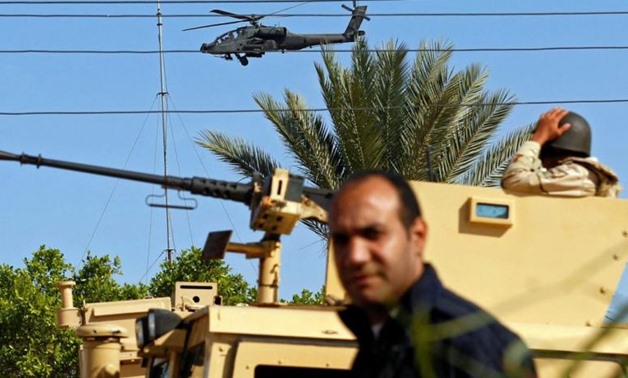
Military forces and helicopters secure an area in North Sinai, Egypt, December 1, 2017. Picture taken December 1, 2017 - REUTERS/Mohamed Abd El Ghany
CAIRO – 12 March 2018: The flow of arms to the Middle East has more than doubled in the past five years, according to the Stockholm International Peace Research Institute (SIPRI). In comparison to the 2008-2012 period, arms transfers to the Middle East increased by 103 percent whilst the volume of global weapons transfers increased by 10 percent.
The Middle East region accounted for 32 percent of global arms imports over the past five years, with Egypt and Saudi Arabia occupying the third and second positions, respectively, in the table of largest arms importers globally.
Under Abdel Fatah al-Sisi’s presidency, Egypt’s arms imports grew by 215 percent in the last five years. Although this increase is drastic, it comes as no surprise. Threats to Egypt’s national security have increased radically since 2013, and Egypt's “War on Terror” has been a defining feature of Sisi's presidency.
The
to rid Egypt’s Sinai of terrorism began on February 9. Titled “Comprehensive Operation Sinai 2018,” the military operation aims to confront all terrorist organizations and elements in the region.
Over the past five years, France has been the most successful country in forging a close relationship with Egypt in the arms industry. Of Egypt’s arms imports across this period, 37 percent came from France, 26 percent from the U.S. and 21 percent from Russia, according to data from SIPRI.
Egypt’s major trade deals
Since the June 30 Revolution against the Muslim Brotherhood, Egypt has invoked a new strategy to diversify its foreign relations. Pushing aside the U.S. who traditionally had a monopoly on Egypt’s military imports, Sisi has diversified the suppliers. France, Russia and Germany, among others, have received sizeable orders for military hardware from the Egyptian regime.
In 2014, President Sisi’s trip to Russia led to a $3.5 billion arms deal that was intended to upgrade Egypt’s missile system and expand Egypt’s already sizable air force. The deal also included 50 MIG-29 fighter jets, MIG-35s, Su-30s and S300 anti-aircraft missiles. In 2015, Egypt signed a deal with Russia for 46 Ka-52 helicopters, and there is still discussion about adapting the order, or writing a new deal, to include Ka-52Ks with naval capability.
 Macron welcomes Al-Sisi at the Elysee Palace - AFP
Macron welcomes Al-Sisi at the Elysee Palace - AFP
Also in 2015, Egypt agreed to purchase 24 Rafale fighter jets from France, as part of a $5.9 billion arms deal, and in 2016, Egypt also agreed to purchase two Mistral helicopter carriers, transforming Egypt’s military capabilities. The ships were originally ordered by and built for the Russian military; however, delivery was withheld when the EU sanctioned Russia over its annexation of Crimea and the conflict in eastern Ukraine.
What else did the report note?
The five biggest exporters, who together accounted for 74 percent of global arms exports, are the United States, Russia, France, Germany and China.
The U.S. continues to dominate arms exports, and it has accounted for 34 percent of total arms exports over the past five years. Its exports were 58 percent higher than those of Russia, who was the world’s second largest arms exporter during the 2013-2017 period.
Notably, Algeria accounted for 52 percent of all African imports over the last five years.
The Stockholm International Peace Research Institute (SIPRI) is an independent international institute, established in 1966, which is dedicated to conflict, armaments, arms control and disarmament research. The SIPRI Arms Transfers Database contains information on all international transfers of major weapons, since 1950.
Its latest report, titled “Asia and the Middle East lead rising trend in arms imports, U.S. exports grow significantly,” highlights the most important trends in the current global arms industry.


Comments
Leave a Comment